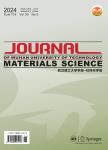Assessment of Toxicity of BSA-conjugated Zinc Oxide Quantum Dots for C2C12 Cells
Assessment of Toxicity of BSA-conjugated Zinc Oxide Quantum Dots for C2C12 Cells作者机构:School of PharmacyGuangdong Medical University
出 版 物:《Journal of Wuhan University of Technology(Materials Science)》 (武汉理工大学学报(材料科学英文版))
年 卷 期:2019年第34卷第3期
页 面:736-743页
核心收录:
学科分类:08[工学] 0805[工学-材料科学与工程(可授工学、理学学位)] 0702[理学-物理学]
基 金:Funded by the Chinese Medicine Science&Technology Foundation of Guangdong Province(No.20151257) Medical Science and Technology Development Foundation of Guangdong Province(No.A2016355) Excellent Young Scientist Training Foundation of Guangdong Province in 2014(No.4CX16054G) Innovation Team Construction Foundationin Ordinary University of Guangdong Province(No.2015KCXTD022) Unique Innovation Foundation in Ordinary University of Guangdong Province(No.2015KTSCX049) Undergraduate Science&Technology Innovation Foundation of Guangdong Province(Nos.201610571041and 201610571015)
主 题:zinc oxide bovine serum albumin quantum dots toxicity cells
摘 要:Colloidal semiconductor nanoparticles (quantum dots, QDs) have attracted a lot of interests in numerous biological and medical applications due to their potent fluorescent properties. However, the possible toxic effects of quantum dots remain an issue of debate. In this study, we aimed to evaluate the cytocompatibility of bovine serum albumin (BSA) conjugated zinc oxide QDs for C2C12 cells. In the experiment, ZnO QDs were synthesized by using BSA as the structure directing agent, and the morphology and crystal phase of ZnO QDs were determined by transmission electron microscopy, X-ray diffractograms and Fourier transform infrared spectrograph techniques. The inverted fluorescence microscope results showed that ZnO QDs were distributed inside the cells. The toxicity of ZnO QDs was assessed by MTT methods, which revealed that ZnO QDs were highly cytocompatible in the concentration less than 200 μM. However, when the concentration of QDs was higher than 1 000 μM ZnO QDs showed significantly toxicity, which was ascribed to generation of free zinc and formation of reactive oxygen species (ROS). Furthermore, the morphological observations exhibited that cells treated with ZnO QDs showed altered morphology, depolymerized cytoskeleton and irregular-shaped nuclei. This study provides helpful guidances on the future safe use and manipulation of QDs to make them suitable tools in nanomedicine.



